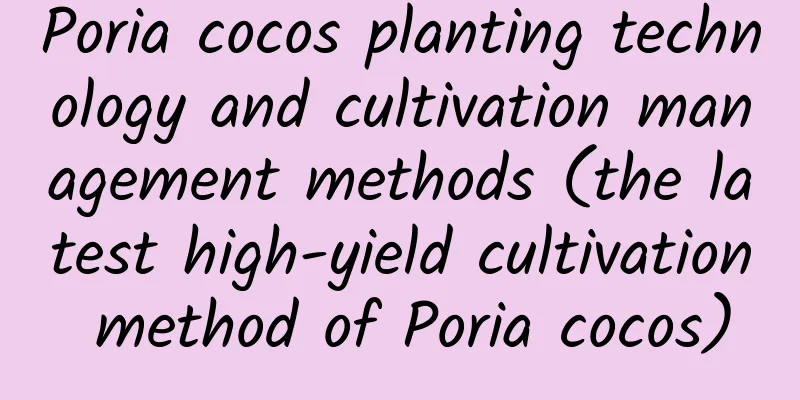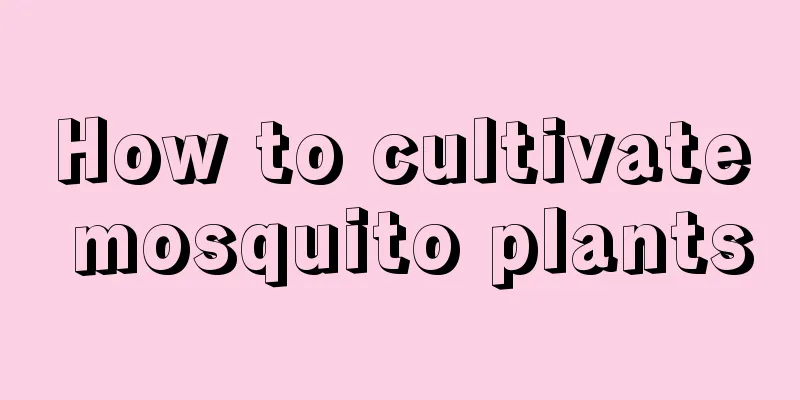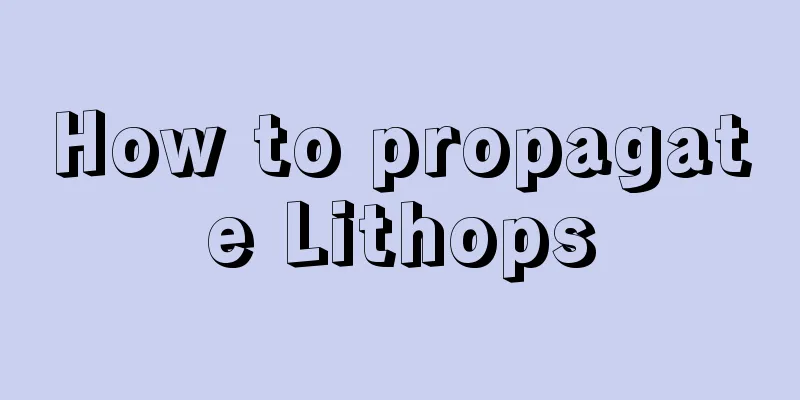Poria cocos planting technology and cultivation management methods (the latest high-yield cultivation method of Poria cocos)

Planting technology and cultivation management of Poria cocosPoria cocos is a common Chinese medicinal material that can also be processed into many foods. In terms of medicinal value, it has a wide range of effects. It not only has the effect of enhancing the body's immune function, but also has obvious anti-tumor and liver protection effects. As people's health awareness increases, the demand for Poria cocos in the market has increased significantly, and the economic benefits of planting Poria cocos are considerable. So how should Poria cocos be planted? Let's take a look at the high-yield planting technology of Poria cocos. ①Prepare materialsThere are certain differences in the cultivation of Poria cocos and other medicinal herbs, the main reason being that it itself is a facultative parasite. Therefore, you need to prepare the materials and cultivate the mycelium before planting so that it can grow normally. The most favorable nutrient for the growth of Poria cocos is pine wood , so we need to prepare pine wood. Then divide it into sections or make it into stumps for material preparation. Each section is about one meter long . Remove the bark and put it on the land, and then cover it with grass. ② Land preparationThe best place to plant Poria cocos is on a slope with sandy soil that has good drainage, as this will provide better drainage. The second step is to deep plow, harrow and level the soil, and then pile up the soil for disinfection and sterilization. Another thing to note is that continuous cropping is prohibited in the planting area of Poria cocos, because there will be a large number of other fungi that will affect the growth of Poria cocos. About half a month before inoculation, deep plowing should be carried out to thoroughly remove impurities and pests in the soil and ensure the growth of Poria cocos. ③ VaccinationPoria cocos can be inoculated in spring and autumn . The steps of inoculation are as follows: The first step is to choose the right strains or fresh Poria cocos. The second step is to dig a cellar on the prepared ground along the slope and place the logs along the dig cellar; The third step is to disinfect the bacteria and the people being vaccinated. This can avoid bacterial infection. After disinfection, evenly place them at the two ends or joints of the logs. Finally, sprinkle a layer of termite killer and cover it lightly with soil. ④ Management1. Check the mycelium About a week after inoculation, white mycelium will grow , and we must check the fungus production in the field in a timely manner. If there is a shortage, replant in time, and then check every ten days or so to see how the fungus is, whether there are dead or foreign fungi. If there are any, remove them in time, otherwise they will infect other healthy fungi. 2. Prevent termites After half a month, if termites appear in the soil, we must exterminate them because termites are the natural enemies of Poria cocos. Finally, we must pay attention to the moisture in the field. If there is too much moisture, it must be drained in time. If the logs are exposed to the ground, soil must be added. ⑤ Disease prevention 1. Fungal infection There are many diseases and pests in the entire process of Poria cocos growth. Here I will only briefly mention a few of them, mainly some fungal infections, such as Trichoderma, Penicillium, etc. The general prevention and control method is to cover the logs with a layer of straw or film when cultivating the soil. This can effectively prevent it, and the second is to spray it with carbendazim. 2. Soft rot In addition, soft rot often occurs in Poria cocos, which is mainly caused by excessive water in the field. First of all, it is necessary to strengthen field management and drain water in time. Then you can also spray it with carbendazim or Bordeaux mixture. 3. Termites Finally, the biggest natural enemy of Poria cocos is termites. We can choose to use termite's natural enemy, ant fungus, to control it, and the second choice is to apply ant killer. |
>>: Why is it difficult to grow pine red plum (why can't the pine red plum bought online survive)
Recommend
How to prune five-color plum
When should the five-color plum be repaired? Seed...
If you grow this kind of "flower" in winter, the colder it gets, the more it blooms, with nearly 200 flowers in one pot!
Of course, there are still flowers that are in th...
How to make the red flower jade produce small balls
illumination The red flower jade likes sunlight a...
Can sunflowers be planted in pots?
Can sunflowers be potted? Sunflowers can be grown...
How to water clematis in spring
1. How to apply water Spring is the season of gro...
Why is the Kalanchoe so lush but not blooming?
1. Leggy Cause: There are many possible reasons w...
How to care for hydroponic spiderwort
Hydroponic method of net grass Net-grass can be g...
Methods and techniques for growing eggplant
1. Choose the variety Before planting eggplant, y...
Can the fortune tree be exposed to the sun or placed on the windowsill?
1. Can it be exposed to the sun? When the sunligh...
How can Yan Rihui grow up so fast?
1. Soil suitability If you want the Sunflower to ...
Common diseases of safflower and their control
Common diseases of red safflower There are three ...
Characteristics of daffodils
1. Root system characteristics The root system of...
Hydrangea cultivation methods and management
Hydrangeas , also known as hydrangeas, are known ...
What is organic fertilizer?
Introduction to Organic Fertilizer Broad Organic ...
How to Spend the Summer with Begonia
How to Spend the Summer with Begonia The summer i...









